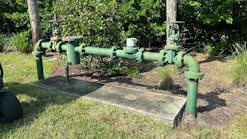“Lincoln Creek itself is about 25 feet wide and, at most, about 3 feet deep,” Stoffel states. “This particular facet of the job involved relocation of an existing 16-inch water main, a move that meant we had to lower it an additional 10 feet from its current depth. The project involved boring under the creek with casings, so we needed to install a work shaft for the jacking operation. Ordinarily that would be a run-of-the-mill job. In this case, however, going to that depth put us in about 22 feet of bedrock.”Getting Down to Boring WorkTo meet the boring contractors specs, a work shaft measuring 35 ft. long x 10 ft. wide x 37 ft. deep was needed. Of that 37 ft., the top 15 ft. of material was overburden consisting mostly of clay, but the remaining depth was solid Wisconsin limestone. Once they were at 37 ft. and had the work shaft dug, using an auger system, the crew would bore under the creek, recounts Stoffel.“In an ideal situation, blasting through that rock would be the logical approach; in fact, it would be the preferred method for removing that rock layer. However, the proximity of an existing bridge and the need to maintain an uninterrupted flow of traffic removed that option from consideration. In preparation for this project, we saw what a Genesis Cyclone [a rock and concrete processor from Genesis Equipment & Manufacturing Inc. in Superior, Wisconsin] could do and felt that it would be the ideal tool for this project. We were right on the mark with our assessment. The attachment, mounted on a Komatsu PC650 [excavator], went through the rock layer with no difficulty at all. Had we been forced to use hydraulic hammers–the traditional tool when blasting is out of the question–we would have easily taken twice as long on the project.”The Perfect StormThe Cyclone is a rotary attachment that uses the excavator’s existing hydraulics to provide the rotation of the tool and pin-on carbide teeth to process even the hardest rock and concrete. Since its introduction, utility companies and contractors have found the Cyclone to be a true, viable alternative to blasting and the use of hammers–particularly in applications in which vibration or collateral damage is a concern.“We would still be out there doing this job with the hammers,” believes Stoffel. “And in addition to the obvious benefits we realized in speed and elimination of vibration, there were other benefits that we hadn’t even considered. For example, the cut is a lot cleaner than anything we would get with either a blast or a hammer. In the case of a hammer in particular, because they tend to slip off a rock ledge being processed, we are mostly left with rough edges in our rock-based digs. The Cyclone provided a nice, uniform, even cut. And the 100-plus yards of material we brought up from the creek project were so uniform in size–ranging in size from three-fourths of an inch to one and a half inches–that it looks a lot like what we call ‘traffic bond.’ We stockpiled the material and will utilize it as fill in washouts and other projects around our yard. In other cases, it can simply be used on-site as fill.”Once it wrapped up the project on the south side of the creek, Super Excavators’s crew moved to the opposite side to make a similar but smaller cut.“The second dig was probably about 6 feet wide by 20 feet long and, again, the same depth. Once the casing was exposed, we hooked onto the pipe, brought it up, and reconnected to the existing water main running from the street.Additional Work AheadStoffel says that with the Cyclone in their arsenal, they feel they will be better equipped to take on additional projects that in the past might not have been as well suited to their capabilities. “Watching the machine, and in discussions with our superintendent and our president Jeff Weekly, we definitely find that it will be a useful tool for us in any number of open-cut scenarios,” he states. “There are areas around here in which rock ledges jump up and then, just as quickly, jump back down again. On other projects in which that has occurred, we’ve had to stop, call in a blasting contractor, wait for them to free up the rock layer, and then proceed. Now we will bring in the Cyclone, grind the rock out of the way, and continue along.”
Larry Trojak
Larry Trojak is owner and president of Trojak Communications, a Ham Lake, Minn.-based marketing communications company. In his 30+ years in business, Trojak has written extensively for a range of markets including: construction, recycling, geopositioning, aggregates processing, wastewater treatment and asphalt production.





